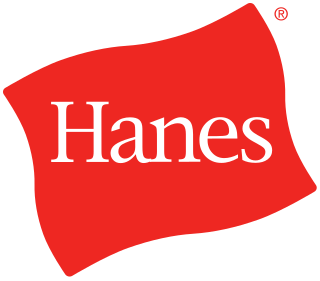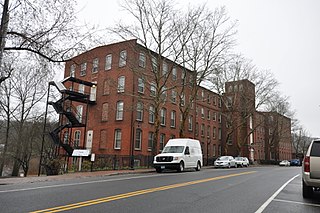
Hanes and Hanes Her Way is a brand of clothing.

The Pennsylvania Match Company, known locally as the Match Factory, was founded in 1899 by Col. W. Fred Reynolds, Joseph L. Montgomery and S. A. Donachy with $200,000 of their own money.

The Brown & Sharpe Manufacturing Company Complex is a historic factory complex in Providence, Rhode Island along the Woonasquatucket River. The 25-acre (10 ha) complex occupies most of a large city block bounded on the south by Promenade Street, the west by Bath and Calverly Streets, the north by West Park Street, and the east by Interstate 95. The complex was the longtime home of Brown & Sharpe Manufacturing Company, a manufacturer of precision equipment founded in 1833. The company was originally located in downtown Providence, but moved to this site in 1872, where it remained until 1964, when it moved to North Kingstown. Fourteen of the company's buildings survive.

The Old Weir Stove Company was an historic industrial facility located on West Water Street in Weir Village, Taunton, Massachusetts. The factory consisted of a series of connected brick buildings, located between West Water Street and the west bank of the Taunton River. The factory was built in 1902 and added to the National Register of Historic Places in 1984. It was later occupied by F.B. Rogers Silver Company. In May–June 2009, the site was demolished, except for the northernmost building of the complex.

The Whittall Mills is an historic industrial complex in southern Worcester, Massachusetts. The complex, which was built between 1870 and 1930, is a reminder of the large carpet manufacturing business that was once a major presence in the city. It is a complex of 15 brick buildings located on a bend of the Middle River, south of Crompton Street and just west of Interstate 290.
Munsingwear was a Minnesota-based brand of underwear from which Original Penguin developed. The company was established as Northwestern Knitting Company. It also was known as PremiumWear.

The Union Mill Complex,, is located at the junction of Milton Avenue and Prospect Street in Ballston Spa, New York, United States. It is a complex of three late 19th-century brick buildings on a 4-acre lot, and the ruins of a dam.

The Pratt, Read and Company Factory Complex is an historic industrial facility located in Deep River, Connecticut. Established in 1863 by Pratt-Read and significantly enlarged in 1914, it was one of the principal sites of ivory processing in Connecticut, producing combs, buttons, and piano keys. The complex was listed on the National Register of Historic Places on August 30, 1984. It has been converted to residences.

The Vassar Swiss Underwear Company Building is an industrial loft building located at 2545 West Diversey Avenue in Chicago, Illinois. It is also known as the Cooper Lamp Building and as of 2010 is slated to house the Green Exchange, a combination business incubator and office space. The building was placed on the National Register of Historic Places in 2008, and as of 2010 is being redeveloped into the Green Exchange, a site for small businesses dedicated to natural products and the environment.

Poughkeepsie Underwear Factory is a historic factory building located at Poughkeepsie, Dutchess County, New York. It was built in 1874 and is a 3+1⁄2-story, eight-bay brick building. It was expanded about 1887.

The Goodwill Industries Building is a former knitting factory in Milwaukee, Wisconsin where Oliver and Robert Friedman developed innovative rehab programs for the blind and mentally handicapped in the 1930s and 40s. The building was added to the National Register of Historic Places in 2004.

Market Square is a furniture showroom complex in High Point, North Carolina, owned by International Market Centers which is the largest building in North Carolina on the National Register of Historic Places (NRHP), and the sixth largest in the United States. Known also as Tomlinson Chair Manufacturing Company Complex, it was listed on the NRHP under that name. The former manufacturing complex includes the oldest factory building in the city, and its renovation has been credited with making High Point a successful furniture exhibition center. A 16-story addition in 1990 is one of the city's tallest buildings.

P.H. Hanes Knitting Company is a historic textile mill complex located at Winston-Salem, Forsyth County, North Carolina. The complex includes three buildings. The Knitting Building or North Building was built in 1920–1921, and is a six-story, Beaux-Arts style concrete and steel building sheathed in brick. The Mill Building or East Building was built in 1928, and is a five-story-plus-basement building of concrete, brick, and steel construction. The Warehouse and Shipping Building was built in 1940, and is a six-story steel frame building sheathed in brick. The P.H. Hanes Knitting Company was founded in 1901 by Pleasant H. Hanes, brother of John W. Hanes who founded Shamrock Mills, later Hanes Hosiery. In February 1965, P. H. Hanes Knitting Company merged with Hanes Hosiery. The downtown mill complex closed in 1965. The complex has been converted to loft apartments.

The Richmond Underwear Company Building is a historic industrial facility at 65 Millet Road in Richmond, Vermont. Built in 1900, it was the town's first major industrial facility, bringing an economic boom to the town. The factory was used for the manufacture of underwear until 1946, and has seen a variety of industrial and commercial uses since then. It was listed on the National Register of Historic Places in 1992.

The Wells-Richardson Complex is a historic commercial-industrial area in downtown Burlington, Vermont. Bounded by Main, Pine, College, and St. Paul Streets just west of City Hall Park, the architecture on this one city block represents nearly a century's worth of development. It is dominated by the former plant of the Wells-Richardson Company, a highly successful maker of patent medicines in the late 19th century. The district was listed on the National Register of Historic Places in 1979.

The H.C. White Company Mill Complex, is a historic industrial complex at 140 Water Street in North Bennington, Vermont. The White Company was founded in 1879, producing stereographic viewers and stereograph cards, as well as the Kiddie-Kar, a three-wheeled wooden scooter for children. These premises were occupied by the company from then until its closure in 1935. The complex, with buildings dating from 1887 to 1919, was listed on the National Register of Historic Places in 2017.

The Western Knitting Mills is a former industrial building located at 400 Water Street in Rochester, Michigan. The building has been renovated to serve commercial tenants, including Rochester Mills Beer Company. It was listed on the National Register of Historic Places in 2000.
Chaska brick is a distinctive brick known for its unique cream color, high clay content, and quality, originating in Chaska, Minnesota, United States. The Chaska brick industry flourished from 1857 until 1950. First called "Chaska brick" in an 1894 Chaska Herald article, this product remains closely tied to the history of the city from which it came.

The Steelcote Manufacturing Company Paint Factory, at 801 Edwin in St. Louis, Missouri, was built in 1922. It was listed on the National Register of Historic Places in 2007.

The Coignet Stone Company Building is a historical structure in the Gowanus neighborhood of Brooklyn in New York City, at the intersection of Third Street and Third Avenue. Designed by architects William Field and Son and constructed between 1872 and 1873, it is the city's oldest remaining concrete building. The Coignet Building is the last remaining structure of a five-acre concrete factory complex built for the Coignet Agglomerate Company along the Gowanus Canal.






















